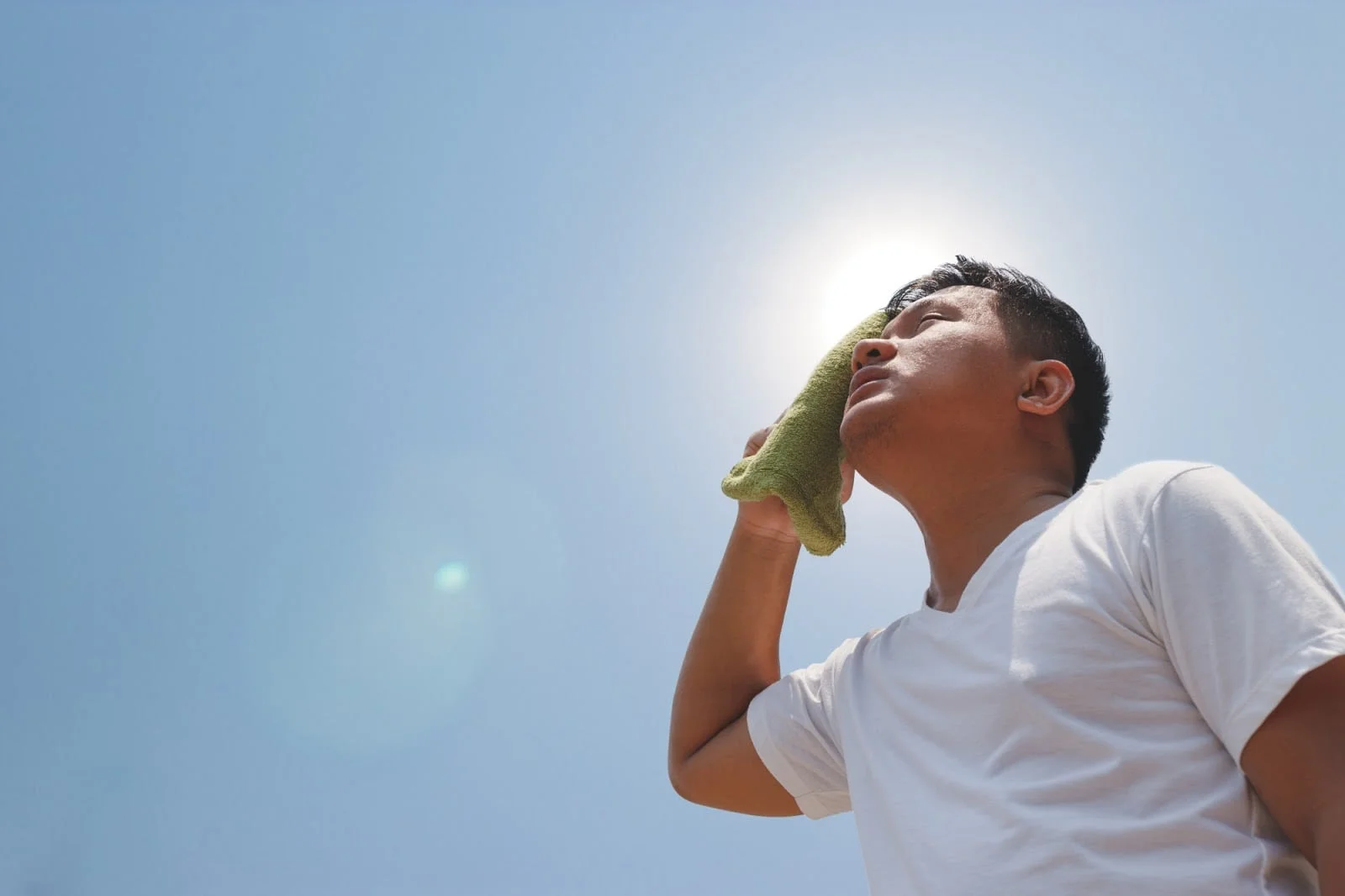Are you dreaming of brighter days? When the sun comes out and it’s time to hit the sand for a fun day at the beach? Or maybe, like many, you’re interested in protecting your skin no matter what time of year it is.
Either way, if you’re reading this, chances are you’re tired of applying the same harsh chemicals to your skin.
Whether that’s because you’re looking to be more environmentally conscious or because those harsh chemicals react badly with your skin, we have good news: there are sunscreen alternatives out there! Here’s what you need to know to select the best natural sunscreen option for you.
Your Skin and the Sun
First, though, it’s important to understand how the sun affects your skin and what sunscreen does to protect your skin.
Sunlight is a bit of a mixed bag for humans. On one hand, UVA radiation is a known carcinogen. However, as the World Health Organization (WHO) notes in its report The Global Burden of Disease Due to Ultraviolet Radiation, excessive UV radiation exposure accounts for just 0.1% of the total global disease burden of disability-adjusted life years (DALYs).
By contrast, the same report noted that 3.3 billion DALYs worldwide result from insufficient levels of UV exposure. Lack of sunlight is known to play a role in a variety of physical and mental health issues, including seasonal affective disorder, a type of seasonal depression directly tied to annual changes in sunlight.
Unsurprisingly, it has a much higher prevalence in areas like Norway, which gets far less sun.
The point is, we do need some sun to take care of our health. It’s one of our best sources of vitamin D. Unfortunately, that doesn’t grant you a free pass to neglect sunscreen every day.
How UV Rays Harm Your Skin
We do need vitamin D from the sun, but UV radiation is known to harm your skin.
The longest UV rays which reach the Earth’s surface are known as UVA rays, while shorter ones are called UVB rays. UVA rays travel deeper into your skin than UVB rays, but both have a detrimental effect on your health. Radiation from either can upset the balance that maintains your skin’s growth and appearance.
If you’ve ever had a sunburn, you know that there is a silver lining: your skin heals. Even when you’re not sunburned, your skin undergoes a constant repair process to undo the effects of UV radiation.
The problem is that your skin has a harder time healing as you age. Over time, your body’s processes to counteract the effects of UV radiation may not be enough to keep pace with ongoing UV damage, and eventually, the damage becomes set in your skin and the underlying connective tissue.
This is what causes your skin to age faster when exposed to UV radiation over time.
The Effects of Cumulative Exposure
Cumulative UV radiation exposure can alter your DNA. Unfortunately, that mutation isn’t as fun as it would be in a superhero movie.
When UV radiation enters skin cells, it causes damage to the DNA of those cells. Because DNA is responsible for how the cell behaves, this can cause the cell to grow and divide unnaturally fast. And since the DNA is damaged, the brakes that would normally prevent a cell from rapid or uncontrolled growth may not work.
This is what leads to clumps of cells called tumors or lesions, which can be malignant (cancerous) or benign (harmless). Some skin cancers are less serious and easily treatable if caught early, but some, like melanoma, are more serious.
How Sunscreen Works
This is where sunscreen comes into play.
The goal of sunscreen is to prevent UV radiation from reaching your skin and causing damage to the cells. To do this, it uses a combination of organic and inorganic chemicals to function as a screen door for your skin. There’s still some light penetration, but not as much as if the screen door wasn’t there.
This is not to be confused with sunblock, which reflects and scatters the light so it can’t reach your skin at all.
What sunscreen screens depend on what the chemical formulation was designed to keep out. There are three regions of ultraviolet light:
-
UV-A radiation, which is involved in deep skin damage
-
UV-B radiation, which is involved in tanning and sunburn
-
UV-C radiation, which is completely absorbed into the Earth’s surface
Different sunscreens rely on different organic chemicals to capture the radiation and release it as heat. Benzophenones and ecamsules, for example, absorb UVA, while para-aminobenzoic acid (PABA) and cinnamates absorb UVB. Anthranilates absorb UVA and UVB.
The degree to which sunscreen protects you (and how long you can stay in the sun before you need to reapply sunscreen) is determined by the Sun Protection Factor (SPF) number on the bottle.
Why You Need Sunscreen
You need sunscreen for one simple reason: sun protection.
Sunscreen grants you a protective layer from the sun’s UV rays that you wouldn’t otherwise have, which means that your skin won’t be damaged by UV rays as easily.
Who Needs Sunscreen?
Who needs sunscreen? Everyone, but it’s more pressing for some than others.
Melanin is the human body’s built-in sunscreen. Everyone has it, but some of us have more of it. Darker-skinned people don’t have more melanin than lighter-skinned people, and they don’t have more melanocytes (the cells that produce melanin) either. But the ones they have tend to be more productive.
This is why some studies believe melanin is the reason why darker skin absorbs 50% to 70% less sunlight than lighter skin. This is all about evolution. If your ancestors lived in Africa, where clouds are something that primarily exists in your imagination and sunlight is overabundant, darker skin was an advantage to outlast the sun.
To be clear: because people of color are often left out of clinical trials and medical studies, there is a chronic lack of sufficient research on the association between dark skin and skin cancer, which leads you to wonder who is being considered in broad medical recommendations.
That said, people of color should still be conscious of skincare and skin checks, as skin cancer can be deadlier among people of color (at least in part because it tends to go undetected longer).
On the other end of the spectrum, it’s a known fact that extremely pale people tend to burn much more easily, as their ancestors passed on skin designed to catch as much light as possible in cold and gray areas that got very little sun (i.e. northern Europe).
When Do You Need Sun Protection?
All the time, anytime you plan on being outdoors. Yes, even if the sun isn’t out.
Given that the Earth revolves around the sun, we aren’t about to escape the sun’s effects anytime soon. Also, the sun’s UV rays are quite good at finding their way to Earth, even on cloudy days–up to 80% of harmful UV radiation can still penetrate your skin on cloudy days.
Remember, radiation is invisible. Just because you can’t see it doesn’t mean it’s not causing damage.
What Level SPF Do You Need?
Different SPF rating exists for a reason. Fortunately, you can get away with different levels of sun protection depending on how much time you spend outdoors.
The SPF number tells you how long it would take the sun’s UVB rays to redden your skin. So when you pick up a lotion marked SPF 70, for example, it would take UVB rays 70 times longer to burn you than if you used no sunscreen (provided that you use it properly).
If you’re inside most of the day with short intervals outdoors, you can get away with SPF of 15 or higher. If you spend a lot of time outdoors, especially where the sun is strong, you should use at least SPF 30 or higher. Higher number SPF ratings block more of the sun’s UV rays, though no SPF completely blocks the radiation.
Regardless of the SPF number, you need to reapply your sunscreen every two hours or so. Higher number SPFs do not last longer than lower number SPFs. If you swim or sweat, reapply more often according to the bottle instructions.
And yes, you do need to reapply it even on cloudy days.
The Problem with Commercial Sunscreen
With that in mind, if you have reservations about commercial sunscreen, unfortunately, you’re right.
While the chemicals in commercial sunscreen protect you against the sun, they also have their effect on your skin cells. And since the skin is unusually good at absorbing things, repeated use of sunscreen essentially means that you’re giving your skin a repeated chemical dose each time you reapply.
To be clear: these chemicals have not been shown to cause skin cancer, and the effects of going without sun protection altogether are worse than exposure to chemicals in commercial sunscreen. But cumulative exposure can affect your health, one that might be worth considering before you slather up.
Chemicals in Sunscreen
There are two types of sunscreen: physical blockers and chemical blockers.
Physical blockers, which reflect ultraviolet rays, usually contain one of two active ingredients: zinc oxide or titanium dioxide. Chemical blockers, which absorb ultraviolet rays, usually contain either aminobenzoic acid, avobenzone, octisalate, octocrylene, and oxybenzone.
Oxybenzone has gotten the worst press for two reasons: concerns that it may act as a hormone disruptor, and concerns about its role in coral bleaching.
All of the active ingredients in commercial sunscreen in the U.S. have been approved by the Food and Drug Administration as safe and effective for human use. The bigger concern is its environmental impact, so much so that Hawaii recently banned sunscreens containing oxybenzone to protect its coral reefs and aquatic life.
The Best Natural Sunscreen Alternatives
If you’re like us, you think that sun protection, environmentalism, and your health shouldn’t have to be mutually exclusive. If anything, you believe the best sun protection skincare should be beneficial to all involved, especially your skin.
With that in mind, let’s take a look at the best natural sunscreen alternatives. Keep in mind that for the best sun protection, it’s a good idea to combine various forms of sun protection.
Wear Clothes
Funnily enough, the best sun protection is the simplest one on the list: wear clothes.
While that itsy-bitsy bikini might be the envy of the beach, it also leaves your skin exposed to the sun. Clothes prevent light from reaching your skin in the first place, which means you won’t risk burning (think of all the tan lines you’ve ever had in your life and you’ll understand what we’re talking about).
We’re not saying you need to dress like a nun or show up to the beach in a full Deadpool suit (unless you’re looking for the entertainment value). Instead, be strategic about covering up.
Once you’ve been in the sun for about 20 minutes, put on a layer of clothes for a while. If it’s summertime and you’re on the beach, go for white clothes, as these reflect the light and help keep you cool and protected all at the same time.
Cover Up
You can also think strategically about how to find sun cover even if you don’t want to pull on a long dress.
For example, make friends with your beach umbrella, especially if you’re planning on lounging outdoors for an extended period (and yes, even if you’re not on the beach). If you’re hosting a backyard party, for example, break out umbrellas and sun cover so that everyone has somewhere to duck out of the sun for a while.
If you’re planning on being mobile, think about what areas are most likely to be exposed to the sun and plan accordingly. If you’re running on the beach, for example, grab a lightweight shirt to protect your shoulders. If you’re snorkeling, grab a UPF rash guard so you don’t fry your back.
These kinds of solutions are especially important for people who are active in the sun. While you might be tempted to shed layers, sweating means that you’ll sweat off sunscreen almost as soon as you apply it. Clothes offer longer-term protection that won’t wash off.
Hats Off! Er…On!
Fun fact: your skin is still soaking up the sun even if you’re not stretched out on the beach to relax. Think about the direction the sun hits when you sit in an arena to watch a sporting event, or when you’re out for a run.
We’re talking about your scalp.
Yes, your scalp can get sunburned just as easily as the rest of you. And yes, it can get burned even if you have hair there (though having less hair does leave your scalp exposed and unprotected).
While you could try to work sunscreen into your hair, it’s frankly not the most efficient option. Instead, wear a hat.
Fortunately, this is pretty easy to turn into a fashion statement. If you’re headed to the ballpark, wear a hat with your team’s insignia. If you’re headed to the beach, you can break out a wide-brimmed, floppy fashionista hat, your favorite ballcap, or anything in between. All styles are welcome here–just make sure you cover your head.
Eat Well
Did you know that you can eat your sunscreen? Not literally, but some foods have been shown to help your skin bounce back from sun exposure and limit the damaging effects of UV rays.
Conversely, some foods make it harder for your skin to recover from sun exposure. Here’s a quick rundown of what to include at lunch and what to skip.
Foods That Harm
Unsurprisingly, the foods that are damaging your skin are all the usual suspects named in ruining your health.
Sugar, everyone’s favorite villain, is the biggest culprit. Any foods that cause a sugar rush can flood your system with excess sugar, and any sugar that isn’t absorbed by your liver can travel to your collagen. Once it gets there, your body thinks that the collagen is damaged goods and gobbles it up.
This leaves your skin less elastic and less able to bounce back from damage.
Common culprits on the sugar front include:
-
White bread
-
Bagels
-
Pasta
-
Sugary baked goods
-
Candy
-
Soda
-
Sweetened teas
-
Sweetened drinks
Also, if you needed a reason to cut back on your drinking, this is it. Alcohol is a known diuretic, which means it dehydrates you. If you’ve ever woken up after a night of margaritas to a swollen and dried-out face, that’s why. Also, the salt on the rim of your margaritas isn’t doing you any favors either.
Foods That Help
Happily, there are several foods you can swap into your diet to help counteract the effects of the sun.
Sweet potatoes and spinach, for example, are both rich in beta carotene, a carotenoid that helps reduce redness when your skin is exposed to UV radiation. Load your plate with kale, mangoes, apricots, carrots, and cantaloupe for more carotenoid action.
In the meantime, stock up on raspberries, strawberries, and pomegranates too–they’re full of ellagic acid, which has been shown to alleviate wrinkling and inflammation caused by UVB radiation.
Tomatoes are also an excellent choice for your lunch, as they’re full of lycopene, an antioxidant. You can also find lycopene in watermelon and pink grapefruit.
If you’re worried about your diet keeping pace with the demands of summer sunshine, no worries. You can still get the sun protection and nutrition support you need with the right supplements, like our Summer Pack.
Aloe Vera
If you’ve ever applied aloe vera gel to a burn, you’re familiar with that luxurious cool rush that comes with it. You also know that the regular application of aloe can speed up and improve burn healing. That’s why it’s long been touted as the burn plant.
Aloe is useful in your sun regimen, but as an organic sunscreen, it’s more of an aftercare tool than a preventative measure. That said, it has been shown to help expedite healing, which can help boost your skin after spending time in the sun.
Mineral Sunscreens
Mineral sunscreens are a newly popular form of sun protection on the market. They’re closest to commercial sunscreens, minus the harmful chemicals. This also means they have protective ingredients proven to work.
Mineral sunscreens generally rely on zinc oxide or titanium dioxide, which you’ll recognize as key ingredients in physical sun blockers. Zinc oxide, in particular, has proven efficacy against the sun.
That said, if you’re making the switch to mineral sunscreens, make sure to read the label carefully. The best mineral sunscreen is the one with high levels of the active ingredients, as these will offer better sun protection than sunscreens with a lower dosage.
Trying Sunscreen Alternatives
At the end of the day, the best sunscreen alternatives all come back to the same idea: better overall health. And if you’re ready to invest in a happier, healthier future, we’re ready to help you make it possible.
We offer patches for all sorts of health concerns, from acne prevention to our favorite combination of vitamins to be your vibrant self. Either way, we’re here to offer the tools you need for better health.
If you’re new to our patches, make sure to check out how to use them. And don’t forget to keep our products close by, whether you’re hitting the beach or just stepping out the door for work.









Leave A Comment
You must be logged in to post a comment.